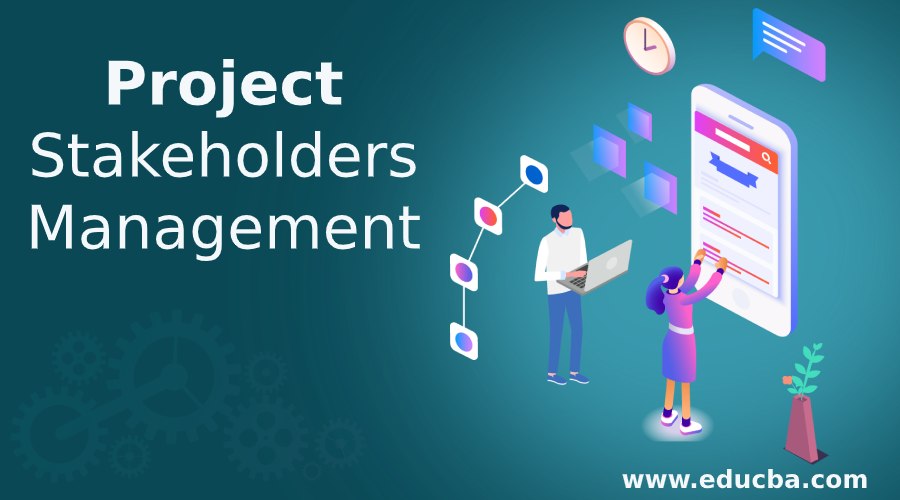Updated June 14, 2023

Introduction to Project Stakeholders Management
A part of defining ourselves as social animals come from the fact that the progress of our civilization and society depends on our interactions with one another. We communicate with each other through a linguistic medium called language and this forms the bridge between understanding and responding to different situations and scenarios.
Even when it comes to our workplace, we are expected to and our work ethics dictate that we remain in a cordial and positive relationship with the people we interact with in order to gain a head-start in attaining the company’s common goal and objective.
In the world of project management, a project manager happens to be the sole person who handles and manages a project and the people involved in that project. So, it becomes an essential factor for this individual to be able to build up a strong bond with each and every stakeholder through communication. This article will address this question that just popped into your head, how exactly to build a positive relationship with all project key stakeholders.
What is Project Stakeholders Management?
Stakeholders are those individuals who are involved in the project and directly or indirectly engaged in the proceedings of the project. It can be divided into two main categories:
- External Project Stakeholders Management: These external stakeholders can affect or be affected by how the project proceeds but they aren’t directly engaged in the business at the organization. These include communities, media, the general public, other public groups, and more.
- Internal Project Stakeholders Management: These stakeholders are directly engaged in the transactions undertaken by the business and at some time or the other are in possession of or associated with the product or service (or part of the product or service) rendered by the organization. These project stakeholders management include employees, customers, vendors, suppliers, stockholders, and more.
The project stakeholders management that you’re surrounded by can be described as two groups: one directly involved in the project and is present on the project steering committee and the other who aren’t key decision-makers but need to be alerted on the progress of the project and how it’s proceeding as per the initial business project plan laid out. Let’s have a closer look at these and how their involvement shapes the flow of the project.
For the smooth functioning of the project, over the years, it has become essential for a dedicated communication line to be established by the project manager with both the internal well as external stakeholders. This line of communication has led to many successes, and failure to communicate to these project key stakeholders in a timely and precise manner has led to the failure of the project itself.
All stakeholders are key players in this game and should be given the same level of priority.
Types of Project Stakeholders Management
Since we have now categorized project stakeholders management into internal and external stakeholders of the organization, we can further look into the types of project stakeholders management there exist based on their level of involvement directly or indirectly within the project.
- People who positively influence the entire project but who are not directly involved in the workings of the project and project plan. These types of project stakeholders management include senior and top managers, suppliers, and the department of finance in the organization
- People who are affected by any of the actions taken within the premise of an organization. They are directly affected and are also instrumental in carrying out the changes that are taken up. They include the employees and customers.
- People who are interested in the success of the organization, especially in terms of returns and revenue earned due to profits. These project key stakeholders influence these change programs and the organization’s product and services to an extent of knowing the benefits the activities result in. These project key stakeholders include individuals who own stock in the business.
As a project manager, your responsibility will be to connect the dots and communicate with all these types of project key stakeholders efficiently so as to bring about cohesiveness within the project and have a successful run with it. This effective communication will ensure that your project runs on the right track throughout its life cycle and that everyone on the project is constantly updated about its progress.
What Do These Project Stakeholders Management Want to Know?
This is one question that all project managers should ask themselves and find satisfying answers to it. It’s important to know what these project stakeholders’ management need to know at all times. Whether they are directly working on the projector only want to know the project’s status and progress, as a good project manager, it’s important that you correctly understand what they want to know and accordingly prepare your communication plan to match project key stakeholders’ needs.
- Project Key Stakeholders Want to Know What’s In It for Them – People are always looking forward to staying motivated once they know what’s in it for them. Once the benefits of their involvement and the project, on the whole, is known to them, it’s like an added boost for them to get a larger sense of responsibility towards the project and contribute accordingly.
- Project Key Stakeholders Want to Know What’s In It for the Organization – People would like to know more about the big picture and look forward to what benefits the organization will receive. After all, if the company progresses, so inflates their opportunities in the larger stake.
- Project Key Stakeholders Want to Trust You – A constant communication line between you and the project stakeholders management can be a great factor to instill trust in the relationship. Stakeholders need to know that they can rely on you for the work they have entrusted you with. Comfort is very important.
- Project Key Stakeholders Want to Know You’re Committed – Communication is a great medium to show your dedication and commitment towards the project you are leading. Once your project stakeholders’ management knows that you’re committed, they will be able to view the project as a great success already and be rest assured that your watchful eyes will guide and consistently progress with the project life cycle.
- Project Key Stakeholders Want to See That You’re Capable – When you effectively communicate the progress of the project or a task to be completed; it shows a lot of your capabilities and caliber to your project’s key stakeholders and team members. The fact that you’re capable of steering the project can have a great and profound effect on how these project stakeholders’ management themselves contribute to the project and render their commitment.
Defining a Positive Relationship
If we’re to maintain a positive relationship with these project key stakeholders who are a very crucial and eminent part of our projects, it’s better for us to understand and clearly define what a positive relationship means. And, no, staying positive isn’t part of the list of project stakeholders management. So, let’s dive head-first and get to define what a positive relationship means to us. The following characteristics in my opinion perfectly describe and define a positive relationship needed while you’re working on your project:
- Trust: Whether it’s your personal relationship or the professional one, trust is one key factor that can be the turning point for you to have a successful and appreciated relationship with your stakeholders. Trust can be a powerful bond, putting the project team and project key stakeholders together for more efficient and effective working and communication environments. With trust comes the fact that you can bring your ideas to the table without being bothered by anything.
- Open and Effective Communication: At an office scenario, you’re continuously in the mode of communication, either through e-mails or IMs or a simple face-to-face conversation. More the communication you will acquire more the relationships, but better and more effective the communication, more positive the relationship would be.
- Allowing for Diversity: Positivity in relationships can cause people to embrace the variation and diversity brought about by other people. They can come up with different opinions, thoughts, and ideas. With their varied perspectives, your project can benefit a lot and you will be tapping into a positive relationship.
- Mutual Concern and Respect: Working as a team and group can be really hard. You can come across individuals who are hard to be around with but having the organization’s bigger picture in mind and based on that set up a mutual concern and respect for each other and within a project, stakeholders can enable innovation and smooth functioning of the project within the team.
- Mindfulness: Being mindful of your actions and words can set you across your project key stakeholders as an accountable and responsible individual who can be mingled with. This can boost your position as a project manager and can help you in getting things done. Self-awareness can save you the trouble of negative vibes around you at your workplace.
Tips to Positively Engage Your Project Stakeholders Management
Below are some tips to positively engage your project stakeholder management.
- Look at not only building a positive relationship with your project stakeholders management but also look forward to a strong relationship that will last through key decision points. Make an effort to constantly involve them in the strategy and the approach taken.
- Share your vision and you are taking on the project and the goal it intends to achieve.
- Take constant advice and help from people who are already on the brighter side of things when it comes to the project and all its tasks.
- Fix a regular meeting schedule to meet directly with your different types of project stakeholders management and invest time into consulting and putting your point forward to resistant project key stakeholders, with a view to getting them to look out for the big picture and understand all that the project stands for.
- Prepare a communication plan and get an agreement with all project key stakeholders on it.
- Communication should be simple yet effective.
- To build up their confidence in you, show them the structured approach towards the project plan right from the start of the project.
- Communicate risks and issues and don’t create a surprise or tense situation suddenly. This will threaten their stake in the project and will inhibit you from taking the lead with trust.
Using a Communication Plan
You have now heard about the communication plan a couple of times in this article. While some may know all about it and some might have heard it for the very first time. Giving the advantage to young and budding project managers out there, you will now get a brief lesson on what a communication plan is and how should you go about with it.
What is a communication plan?
A communication plan, simply put, facilitates efficient and effective communication between you, as a project manager, and the various stakeholders you will be dealing with while on the project. This plan will be a complete guide directing you through all the communication that will take place and at what frequency.
When establishing the communication plan, you will have to take the buy-in from:
- Project Sponsor
- Project Stakeholders Management
Elements of a communication plan
For a good and successful communication plan to take root, you will have to take the following 4 elements of the plan:
- Communication objectives
- Method and frequency of communication
- Type of stakeholders (target audience)
- Key elements employed in communication
Developing a communication plan
This task can be easily conducted provided you have all the communication strategies up and clear in your mind. Once you know and realize what needs to be done, said, and acted upon, you can be sure of developing a communication plan that will not fail. Given in the following table are ideal and recommended strategies to be undertaken to carefully carve and sculpt a good communication plan in order to build a positive relationship with your project stakeholders Management.
| Focus Points | Questions |
| Communication objectives | What do you want to achieve with your communication plan for your project?
Are these objectives in alignment with the objectives of your project? |
| Target audiences | Who needs these kinds of communication?
What’s in it for them? |
| Method of communication | What is your target audience comfortable with as their mode of communication? |
| A frequency of communication | How often do you want your stakeholders to be updated? |
| Purpose of communication with different types of stakeholders | Why do you want to communicate this piece of information to this type of stakeholder?
|
| Key elements in communication | What do you precisely need them to know?
What do you as a project manager wants to convey to them? |
| Communication master | Who should deliver the communication that you have planned for?
Which team member is responsible enough to render such a communication? Do different stakeholders need different communicators? |
| Sources of information | What is your source of information in order to be able to communicate?
What data and information will you use? What’s the need for this particular piece of information for this particular stakeholder? |
| Success metrics | How do I know my communication plan is working?
What deems it a successful communication plan? Do I need to have a communication plan evaluation meeting? |
Recommended Articles
This is a guide to Project Stakeholders Management. Here we have discussed the basic concept, Elements of a communication plan, along with Types of Project Stakeholders Management. You may look at the following articles to learn more –


